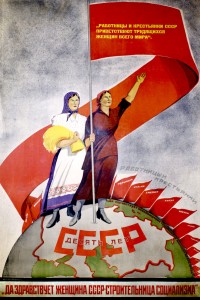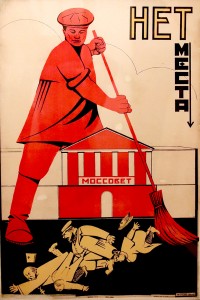Proletkult (Proletarian Culture) Studios
Proletarskaia Kultura (Proletarian Culture) or Proletkult, consisted of architects, composers, artists and writers. The consortium was created in 1917 by Alexandr Bogdanov, director of the Socialist Academy of Social Sciences, and by Aleksei Gastev, a writer and theoretician who headed the Central Institute of Labor. Proletkult was to provide the foundation for a worker-based art form, "liberated from bourgeois, pre-Soviet culture." Mass-production and machine art were staples of the Proletkult ideal. Its membership surged following the October Revolution of 1917. An estimated 80,000 members were counted by 1920.
The manifesto of Proletkult was simple: 1) proletarian culture equals communism, 2) Proletkult is the responsibility of the Russian Communist Party, 3) proletariat class equals the Russian Communist Party that equals Soviet power.
While Bogdanov's brother-in-law was Anatolii Lunacharskii (head of the Ministry of Education), the connection did not afford Proletkult lasting influence. The consortium’s membership declined after 1920 when Soviet leader Vladimir Lenin condemned its autonomy via a directive “On Proletkults”. Following a consolidation of artists' clubs and societies in 1932, Proletkult was formally dismantled by the government.
Bogdanov died in 1928 after performing a blood transfusion experiment on himself. Gastev was arrested in 1938 and charged with “counter-revolutionary” acts. He was executed in 1939.
Sources & Citations
Khan, A., et.al. (2018). A History of Russian Literature. Oxford: Oxford Univ. Press. (pp. 529-530)
Krementsov, N. L. (2011). A Martian Stranded on Earth: Alexander Bogdanov, Blood Transfusions, and Proletarian Science. Chicago: University of Chicago Press.
Milner, J. (1993). A Dictionary of Russian and Soviet Artists 1420-1970. Woodbridge: Antique Collectors' Club. (p. 243)
Bown, M. C. (1991). Art under Stalin. Oxford: Holmes & Meier. (pp. 19-20)
![PP 339: March 8th [International Women's Day], a day of celebration of the fighting forces of the working women and peasants of all countries.](https://www.posterplakat.com/thumbs/the-collection/posters/pp-339/pp339-200x300.jpg)


![PP 1118: Do not forget [from] March 25 to April 6
Elections to the Soviet - Show your strength
Red Moscow.](https://www.posterplakat.com/thumbs/the-collection/posters/pp-1118/pp-1118-catalog-image-178x300.jpg)